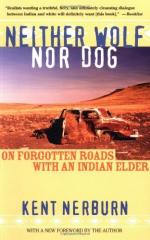|
This section contains 590 words (approx. 2 pages at 400 words per page) |

|
Neither Wolf nor Dog: On Forgotten Roads with an Indian Elder Summary & Study Guide Description
Neither Wolf nor Dog: On Forgotten Roads with an Indian Elder Summary & Study Guide includes comprehensive information and analysis to help you understand the book. This study guide contains the following sections:
This detailed literature summary also contains Topics for Discussion and a Free Quiz on Neither Wolf nor Dog: On Forgotten Roads with an Indian Elder by Kent Nerburn.
This novel, published in 1994 and updated in 2002, takes place in current time and presents a non-fictional presentation of Lakota Indian themes, lifestyle and conflicts experienced by an eighty-some-year-old elder together with his family and friends. This is an enjoyable and light-hearted read despite its potentially heavy subject matter, which deals with racial prejudice, genocide and inability of this respected and aging elder to forgive and forget the pains of his early life and that of his tribe. The author of "Neither Wolf nor Dog, On Forgotten Roads with an Indian Elder" is Kent Nerburn. He is an educator with a doctorate in Religion and Art, focused on Native American issues and education. Nerburn is famous in northern Minnesota to people of the Red Lake Ojibwe Reservation. His award-winning work produced two books titled, "To Walk the Red Road" and "We Choose to Remember", with the memories of tribal elders, plus several other works.
Kent Nerburn traveled by motorcycle on a hot August day to a North Dakota historical market with a rock shaped like a buffalo within a fenced site that he saw as a metaphor for the plight of the Lakota Indian people. He vowed then to bridge the gap between his people and the Lakota by writing this book, which is the fulfillment of that obligation. He wrote "Neither Wolf nor Dog, On Forgotten Roads with an Indian Elder" to spread the faith in ourselves, others and the common humanity we share despite our differences.
The author is fully involved in the life and time of this Lakota elder named Dan. Dan is an elder who is the subject and at the center of the author Nerburn's absorbing work with Lakota Indians. Nerburn is a white man and trusted friend to Dan, the Lakota elder, and Grover is an Indian and also his trusted friend. Dan is able to understand both white man and Indian points of view. The elder Dan takes pride in seeing with the two eyes of a white man and an Indian. This is a tightly-knit family of Lakota people by whom Nerburn is invited in as an inside-outsider until he learns a family secret and becomes Kent, the person who bridges the gap from Dan to Danelle. Dan has not forgiven himself for the half-breed son he sired with the white lady from the East that he presented to Nerburn as his dead grandson. Only as Kent can Nerburn offer a white man's acceptance of Dan's half-breed grandson Myron.
This 334 page book titled "Neither Wolf nor Dog; On Forgotten Roads with an Indian Elder" is comprised of a foreword, introduction, and twenty-six numbered and titled chapters, plus back matter about the author. Chapters range from six to twenty-two pages and have descriptive titles. For example, the first chapter is titled "An Old Man's Request" and sets the theme for the book, while the fifteenth chapter titled "Shiny Soup" describes the fare in a local diner. Twenty-six chapters plus the introduction are organized for this summary in ten sections, grouped consecutively by subject matter. Chapter titles offer descriptive data about chapter subjects. The language of the book is simply written and understood with few unclear concepts. Dialogue between characters is used liberally for an earthy approach to various subjects the characters discuss. Humor is ever-present to keep interest and momentum. For example, Jumbo, a mechanic, is described in terms like huge and four hundred pounds that fit his name and the dog Fatback has a fat belly that is low-hanging.
Read more from the Study Guide
|
This section contains 590 words (approx. 2 pages at 400 words per page) |

|



